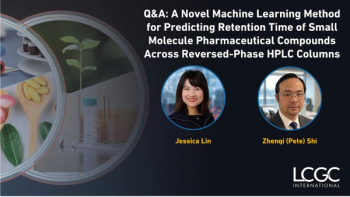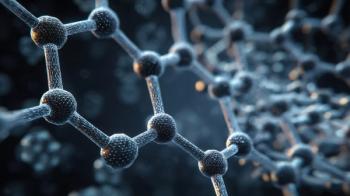Key Points:
- GLP-1 therapeutics are gaining popularity beyond diabetes due to their surprising efficacy in weight management and emerging potential in a broad range of diseases.
- Peptide-based GLP-1 drugs offer flexibility and innovation, but their structural complexity presents analytical challenges.
- Cutting-edge analytical techniques like HILIC, 2D LC, and bio-inert systems are critical for comprehensive GLP-1 characterization.
Martin Vollmer, biopharma program manager at Agilent Technologies, spoke to LCGC International about the evolving importance of glucagon-like peptide-1 (GLP-1) therapeutics and the challenges they present to separation scientists.
What are glucagon-like peptide-1 (GLP-1) therapeutics, and why are they becoming more popular?
GLP-1 therapeutics are molecules that act on the incretin pathway, influencing sugar metabolism in the body. They were initially developed for the treatment of type 2 diabetes, and most of the current drugs are peptides composed of 25–50 amino acids, although small molecules and antibodies are also in development.
While these drugs have been in use for over a decade, their dramatic impact on chronic weight management has recently propelled them into the spotlight. This unexpected benefit triggered a surge of interest—not only from the medical community but also from broader sectors such as the beauty and wellness industry. As researchers began to explore why these drugs were so effective for weight loss, they uncovered potential applications in a wide range of other conditions, including cardiovascular, neurological, and psychiatric disorders.
What therapeutic areas are they being used in?
GLP-1 therapeutics have rapidly expanded into a wide range of therapeutic areas because of their ability to act on multiple organs—including the brain, pancreas, stomach, and kidneys—which enables diverse physiological effects. Combined with their favorable safety and efficacy profiles, this has made them attractive candidates for treating a variety of conditions. As already mentioned, the most prominent and commercially impactful use today is in chronic weight management, which has significantly contributed to their mainstream popularity. Beyond these core indications, GLP-1 receptor agonists are being explored or used in non-alcoholic fatty liver disease (NAFLD), particularly non-alcoholic steatohepatitis (NASH), where metabolic regulation is key; diabetic nephropathy, offering renal protective effects in diabetic patients; cardiovascular conditions, including heart failure and peripheral artery disease, where GLP-1s may offer protective benefits; sleep apnea, due to their impact on weight and metabolic regulation; neurodegenerative disorders, early research suggests potential neuroprotective effects; and gastrointestinal and psychiatric disorders. These are emerging areas of interest, with ongoing research into how GLP-1s may influence gut-brain signalling and mood regulation.
What makes peptides particularly suitable for GLP-1 drug development?
Peptides are especially well-suited for GLP-1 therapeutics due to their structural flexibility, manufacturing versatility, and biological compatibility. Most GLP-1 drugs on the market today are peptides composed of 25–50 amino acids, and they offer several key advantages:
Dual manufacturing routes: Peptides can be produced either through chemical synthesis, for example, solid-phase peptide synthesis, or recombinant expression (such as in mammalian cell cultures). This flexibility allows developers to choose the most efficient or scalable method depending on the molecule’s complexity and intended use.
Ease of modification: Peptides can be chemically modified to enhance their pharmacokinetic properties. For example, GLP-1 analogs are often conjugated with fatty acids or incorporate non-natural amino acids to improve stability, extend half-life, or enable oral delivery. These modifications are relatively straightforward compared to the engineering of larger biologics like monoclonal antibodies.
Multi-receptor targeting: Newer GLP-1 drugs are being designed to act on multiple receptors, broadening their therapeutic potential. This is made possible by the modular nature of peptides, which allows for precise tuning of receptor binding and activity.
Simpler structure compared to antibodies: Unlike monoclonal antibodies, which are large and structurally complex, peptides are smaller and more predictable, making them easier to characterize, purify, and validate during development and manufacturing.
These attributes make peptides an ideal platform for GLP-1 drug development, enabling rapid innovation and adaptation to emerging therapeutic needs.
What are the challenges of analyzing these compounds from a separation science perspective?
GLP-1s are usually peptides, and peptide analysis has been well established for some time. The main challenges in analysis stem from their structural complexity. While they are peptides, they are often conjugated with fatty acids or contain artificial amino acids, which alter their physicochemical properties, for example, an increase in hydrophobicity. In addition, the method of manufacture—chemical synthesis vs. recombinant expression—introduces different impurity profiles. Ensuring accurate impurity detection and maintaining safety and efficacy is analytically demanding.
What techniques are commonly used to analyze these molecules?
The analysis of GLP-1 therapeutics can require a multi-technique approach because of their structural complexity and the diversity of impurities introduced during synthesis or formulation. Commonly used techniques include high performance liquid chromatography (HPLC), the foundational technique for separating the main compound from impurities and degradation products, it provides a clear impurity profile and is widely used in both development and quality control (QC) settings; liquid chromatography–mass spectrometry (LC–MS): essential for confirming the peptide sequence, conjugation sites, and modifications, for example, fatty acid attachments. LC–MS offers high sensitivity and specificity, which is particularly valuable during early development and characterization; ELISA (enzyme-linked immunosorbent assay) and PCR (polymerase chain reaction): used in potency assays to assess biological activity, particularly in cell-based or receptor-binding formats; spectroscopy: applied for detecting process-related impurities such as metal ions or excipients that may not be visible via chromatographic methods; microbiology-based techniques: important for detecting contaminants, especially in recombinantly manufactured peptides; and cell-based assays: these are used to evaluate bioactivity and functional performance, particularly for peptides produced via recombinant expression.
The choice of technique depends on the specific analytical goal.
In your talk, you described a hydrophilic interaction liquid chromatography (HILIC) method for analyzing receptor agonists and excipients using a diode array detector (DAD) and an evaporative light scattering detector (ELSD). What was innovative about this approach, and what were your main findings?
The innovation in this method lies in its comprehensive and orthogonal analytical capability. Traditionally, reverse-phase HPLC is used for peptide analysis (1), but in this case, we used hydrophilic interaction liquid chromatography (HILIC), which operates on a fundamentally different separation principle. This allowed the team to simultaneously analyze both the active pharmaceutical ingredient (API) and formulation components, such as phosphate ions and other excipients, within a single method. It also meant we could detect impurities not only from the drug substance but also those arising from the formulation process—something not typically achievable with standard methods.
Another key innovation was the use of a bio-inert LC system. This system features passivated surfaces, which significantly improved peak shapes for certain analytes—especially ions that tend to interact with stainless steel surfaces. This enhancement in chromatographic performance demonstrated the clear advantage of using bio-LC systems for sensitive analytes.
The method incorporated dual detection using DAD and ELSD. While DAD is effective for compounds with chromophores, ELSD enabled the detection of non-chromophoric species—such as certain ions and excipients—that would otherwise go unnoticed. This complementary detection strategy ensured a more complete and robust analysis.
You also described the role of 2D LC in your presentation. Can you elaborate on the role of 2D LC for GLP-1 analysis? What benefits does it offer the analyst, and for what type of applications?
Two-dimensional liquid chromatography (2D LC) plays a critical role in enhancing the resolution and confidence of GLP-1 analysis, especially when dealing with complex peptide formulations and impurity profiles. In the context of GLP-1 therapeutics, where structural modifications, for example, fatty acid conjugation, artificial amino acids, and diverse manufacturing routes (chemical vs. recombinant) introduce a wide range of potential impurities, 2D LC offers several key advantages:
Orthogonal separation: By combining two different separation mechanisms (for example, reverse-phase in the first dimension and HILIC or ion-exchange in the second), 2D LC can resolve impurities that coelute in traditional 1D LC. This is particularly valuable when impurities are masked under the main peak or when the impurity profile is complex.
Enhanced impurity detection: 2D LC allows analysts to uncover hidden or low-level impurities that might otherwise go undetected. This is crucial for ensuring the safety and efficacy of GLP-1 drugs, especially in late-stage development and quality control.
Structural elucidation: When coupled with mass spectrometry, 2D LC enables detailed characterization of unknown peaks. Analysts can isolate specific fractions (for example, via multiple heart-cutting) and subject them to further analysis, helping to identify degradation products, process-related impurities, or formulation-related artifacts.
Application versatility: 2D LC is particularly useful in method development and validation, stability studies, comparability assessments (such as biosimilars), and investigating batch-to-batch variability.
2D LC platforms are available that support advanced features such as multiple heart-cutting, which allows selective transfer of impurity peaks from the first to the second dimension for deeper analysis. This targeted approach improves efficiency and data quality, making it a powerful tool for analysts working with complex biotherapeutics like GLP-1 receptor agonists.
What tools are you highlighting at HPLC 2025 specifically for GLP-1 analysis?
Agilent views GLP-1 analysis as a strategic priority within its biopharma portfolio. We already offer a comprehensive suite of tools for analyzing these molecules. The InfinityLab Bio LC and Bio-Inert LC systems are designed for robustness and ease of use, especially in QC environments. The Infinity III HPLC system offers intelligent monitoring and simplified method setup. The Agilent 6495C and 6550 iFunnel LC/Q-TOF systems are high-sensitivity mass spectrometry instruments that are needed to analyze the compounds. The Agilent IQ Pro is a newly launched MS platform that simplifies operation for non-experts, which is ideal for QC labs.
These tools are supported by a wide range of columns, software, and services tailored for GLP-1 analysis.
Reference
(1) Domon, B.; Aebersold, R. Mass Spectrometry and Protein Analysis. Science 2006, 312 (5771), 212–217. DOI: 10.1126/science.1124619
Martin Vollmer has been with Agilent for 22 years, with positions in R&D, project management, marketing, product management, and marketing management. In 2019, he became the biopharma program manager in the Life Science Analysis Group. He is responsible for strategy development and execution for the biopharma end-market and for coordinating customer-centric solution development across multiple instrument divisions.





